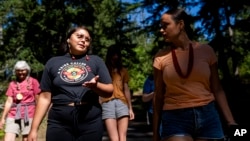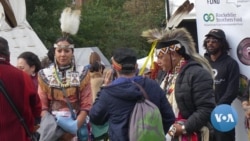Monday in the United States is celebrated as both Columbus Day and as Indigenous Peoples' Day.
When the Spanish-financed Italian explorer Christopher Columbus made contact with native inhabitants of the Caribbean in 1492, there were more than 500 languages spoken across the Americas. In the land that became the United States, the remaining number of such languages has dwindled to about 100. Most now have only a handful of speakers.
Alex Fire Thunder’s two young boys are a thriving exception as their ethnic Lakota language again has thousands of aspiring speakers.
“I want them to have a strong sense of their Lakota identity. Language is everything. It’s something that nobody can take away from them,” says Fire Thunder, Oglala Lakota from the Pine Ridge Reservation in South Dakota and deputy director of the Lakȟól'iyapi kiŋ nawéčižiŋ (Lakota Language Consortium).
Fire Thunder is optimistic his sons, Odowan, 3, and Iyoyanpa, 2, will have others besides themselves to converse in Lakota when they grow up.
“There are immersion schools. There are other second-language learners learning the language and teaching their children,” Fire Thunder, who has been among those formally teaching Lakota in schools, tells VOA.
That was not the case for decades.
“My mom is a speaker, but she did not transmit the language to my siblings and I,” he says.
For generations, Native American children in North America were sent to boarding schools where they were immersed in American culture and punished for speaking their own languages.
Teaching and learning these Indigenous languages in the 21st century are a challenge because there are scant resources and opportunities remaining.
“If you want to learn Spanish, there are a number of countries you can go to where all you’re going to hear is Spanish and you’re going to be expected to speak Spanish, as well,” Fire Thunder says.
For Lakota learners there are limited options. Some elders converse in Lakota at the post office or senior centers.
“The elders that do speak are, at this point and time, all bilingual so there is no situation where you absolutely have to use Lakota,” Fire Thunder explains. “That’s something you’re not going to find if you go to Spain or Mexico.”
Lakota is part of the Sioux language group and primarily heard in the Dakotas. A unique aspect of the language is the use of kinship terms, considered an essential to Lakota cultural expression, and many of the terms do not have precise English equivalents.
“There are only about 10 to 15 languages left in the U.S. that have any viable chances in terms of moving forward beyond the next 50 years,” according to Wilhelm Meya, chairman of The Language Conservancy.
When languages lose their last fluent speakers, it can also mean the demise of their Indigenous songs and prayers.
“The average speaker is about 75. Children for the most part are not learning the language,” Meya tells VOA. “So, there’s a lot to do in order to try to get these languages back on their feet.”
Meya’s organization is a nonprofit dedicated to preserving, protecting and promoting endangered languages. It currently partners with 52 Indigenous communities. One successful project has been the creation of the New Lakota Dictionary, considered the most expansive Native American dictionary.
Hundreds of Indigenous linguists, educators and scholars are to gather this week in Bloomington, Indiana, to share knowledge and inspire language revitalization efforts.
“For the elders and the speakers, they want to pass on the language, and they want to do so with hope they’re going to leave a legacy for generations going forward,” Meya says.








